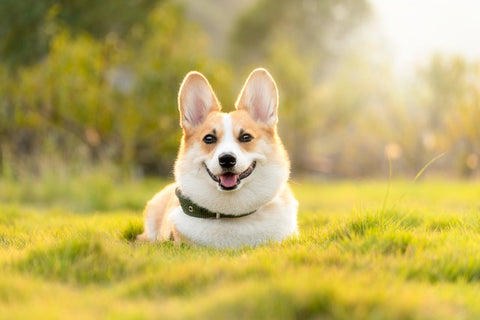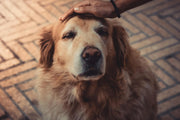
You may be wondering: is my dog overweight? There are several ways to tell if your dog is overweight, and we will cover them in detail below. It's important to know that an obese dog may not live as long as his leaner counterparts and is prone to various health risks.
I wanted to share a couple of statistics on dog obesity:
- Obese pets live 2.5 years shorter on average than their non-obese counterparts (source: Banfield Pet Hospital)
- Approximately 30% of the general canine population is obese, with 45% of dogs aged 5-11 years old weighing more than their ideal weight (source: VCA Hospitals)
A healthy weight is paramount to helping your pup live as long as possible and improving his quality of life. Sometimes, you may need to make some dietary adjustments and put your dog on a vet-recommended exercise plan to help your dog reach the desired body weight.
Dog weight loss is a serious matter and should be discussed with your veterinarian to ensure that your dog's dietary needs are still fulfilled. Decreasing portion size can be dangerous and lead to malnourishment. Any information in this article does not constitute medical advice.
Is my dog overweight?

There are various ways to tell if your dog is carrying extra weight. Obesity in dogs is defined as having an extra layer of fat that is not necessary and detrimental to your dog's health.
Previously, fat was considered inactive tissue and therefore not necessarily unhealthy. However, more recent research has shown that fat layers secrete inflammatory hormones and create oxidative stress. Both contribute to many diseases.
1. Check out the overweight dog chart.

Veterinarians usually use a scoring system from 1 to 5 or 1 to 9. In the first case, 3 is considered normal and in the other, 5 is deemed to be normal. Contrary to popular belief, dogs depicted in media and on TV may be overweight and influence what we consider "normal."
Use the image above to assess your dog's weight and determine whether he is overweight. Let's also look at other ways to tell if your dog is overweight below.
2. Feel your dog's ribs
The easiest way to assess your dog's weight is to feel his ribs. If you hold your hand palm down and touch your knuckles with the flats of the fingers on the opposite hand, this is how your dog's ribs should feel.
If you feel a thick layer of fat over his ribs, your dog may be overweight.
3. Look for your pup's waist.
If you can't clearly see your pup's waistline from above, or if you can't see a clear distinction between their chest and stomach from the side, your dog may be overweight.
4. Look for the Tuck-Up
Your dog's chest should be significantly wider than his abdomen, and there will be a tuck-up from his chest to his stomach.
Monitor your dog's energy & endurance

The last way to tell if your dog is overweight is to look at his behavior during exercise and at home:
- Is your pup panting when walking?
- Is your pup walking slower than he should?
- Is your dog sleeping more than usual?
If you answered yes to any of the questions above, your dog might be overweight. Look below to know how dog owners can help overweight dogs lose weight.
Health problems associated with overweight dogs
Unfortunately, overweight dogs might be prone to health problems. Also, obese dogs will likely have a shorter lifespan than their leaner fellow four-legged friends. Weight management is therefore essential to support dogs' health.
Let's look at some severe health conditions that are more likely in overweight dogs:
- Arthritis
- Diabetes
- Many types of cancer
- Heart disease
- Hypertension
- Breathing difficulties
- Respiratory disease
- Urinary bladder stones
- High blood pressure
- Joint injuries
You may be wondering what steps you can take to help your dog reach his ideal weight. Most vet-recommended solutions will include a diet and exercise plan.
How can I help my dog lose weight?

There are a few ways to help your canine companion lose weight. Once again, please consult your veterinarian to determine what's most appropriate for your dog. Your vet will help:
- Assess your dog's body condition score
- Determine the ideal body weight
- Recommend a low-calorie diet food, if necessary, or a balanced diet
- Recommend a strict exercise schedule
- Recommend an overall weight loss plan
Let's look at what can be done with exercise & diet below.
Regular exercise
Please read my article to determine how long you should walk your dog daily based on his breed. Unless you have a small dog, 30 minutes a day or just one walk a day is not enough.
You may also consider adding more playtime, such as playing fetch and frisbee in a nearby dog park. It will add more fun to your day and help your pup burn some extra calories.
Adjust diet
There is no miracle behind losing weight. It mostly comes from food. Remember that reducing the portions may be counterproductive and lead to malnutrition. It is because portion sizes include the daily recommended amount of certain nutrients, and by going below the portion size, dogs may not receive all the nutrients they need.
Instead, a lower-calorie diet with the same healthy nutrients may be recommended. Often, it is beneficial to feed your dog several small meals throughout the day instead of just once a day.
Feeding chart

Please look at the feeding chart above when trying to determine how much kibble to feed your dog. Always use a standard eight oz. Measuring cup. Here are some examples:
- Feed 1/3 cup of 139 calories to a 3-lb dog.
- Feed 1 cup or 464 calories to a 15-lb dog.
- Feed 3 cups or 1313 calories to a 60-lb dog.
Puppies may require 2-3 times the adult portion size. Always provide plenty of water. Please ask your veterinarian how to best feed pregnant or nursing dogs.
What causes dogs to become overweight?
There are various reasons behind dogs becoming overweight. However, as I said above, images and videos shared in media may not depict dogs with a healthy weight.
Inappropriate food & diet
Dogs fed high-calorie puppy food will gain more weight than they should.
Another reason is if the dog's regular diet is supplemented with extra treats. Only a few treats a day can add up to too many calories and slow weight gain over time.
Dogs fed table scraps can also put on weight as it's harder to judge the correct portion size. Not only this, but table scraps may be unhealthy for dogs.
Finally, a study showed that low-quality pet food is more prevalent in obese dogs. Therefore, picking a higher quality food could help dogs maintain a healthy weight.
Age
Older dogs are not as energetic as their younger selves and may need about 20% fewer calories than younger adult dogs. Therefore, when they continue to eat the same portion size, they can put on weight.
Lack of exercise
All dogs, even older ones, need daily exercise. Lack of exercise is a direct contributing factor to dog obesity and can lead to boredom and oversleeping.
Neutering
In some cases, neutering can lead to obesity by affecting your dog's appetite. Discuss this with your pet to see if it could be the case and what steps you can take.
Lifestyle & family factors
Pet parents may find it challenging to know the proper weight for their dog and know how to spot early signs of obesity.
Breed predisposition
Cocker Spaniels, Cairn Terriers, Labrador Retrievers, and Golden Retrievers are more likely to be overweight.




